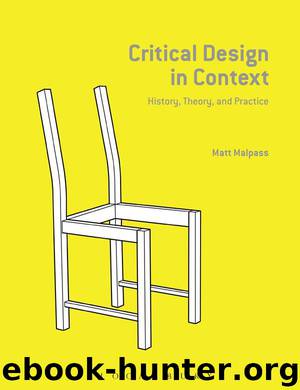Critical Design in Context by Matt Malpass

Author:Matt Malpass [Malpass, Matt]
Language: eng
Format: epub
Publisher: Bloomsbury Publishing
Published: 2017-02-23T00:00:00+00:00
The paradox of critical design in commercial use
The critical social theorist Craig Calhoun suggests that critical reflection on the way things are, with their underlying, often hidden factors, enables exploration of other possibilities, and can allow an improvement in the way things are (Calhoun 1995). How these critical practices improve the way things are is not an easy subject. On the one hand, enabling, affording, and evoking critical reflection, discussion, debate, and speculation is typically considered an improvement in itself. On the other hand, to make critique meaningful, it must be directed at those who contribute to the culture that is being critiqued (Koskinen et al. 2011). This would necessitate a movement out of the gallery, and the perception of critical design as intellectual debates ‘by designers for designers’. It would also shift the role of debate from an end to a means. I have discussed the instrumental use of critical design in design research and as an effective tool in contexts of science and technology, but there are a limited number of examples where critical design has been used instrumentally in a product design industry context.
It could be argued that the technology company Philips carries out activity in this area. Gardien’s (2006) design-led horizon innovation model proposes a framework that Philips designers use to think about short-, medium-, and long-term futures. Horizon 1, horizon 2, and horizon 3 reflect short-, medium-, and long-term futures. Each horizon explores a different time space and therefore needs a different foresight in design approach and input. Horizon 3 is about radical innovation and transformation and creates a space where critical design might have commercial application in its ability to provoke debate and test societal expectations. Deliverables range from scenarios and narratives to the creation of experience prototypes. An example of this is Auger’s Smell+ project (discussed in Chapter 5). Intel and Microsoft have also initiated briefs with research centres and universities to carry out work that might not align with core business but are conceived with an interest to probe future social, political, and economic expectations and possibilities. In such activity, the commercial sector recognizes design’s ability to visualize and make issues tangible through scenarios of use and object form. Walker (2010) describes how design carried out from within an academic context can contribute in commercial, mainstream contexts as it confronts contemporary issues and complex problems:
We must find ways to renew the profession by developing agendas and propositions that envision what is desirable, meaningful, and sustainable; the responsibility to do so lies partly with those in the profession itself and partly with the academic institutions that educate and train its future participants. (2010, 97)
He argues that design in academia has the opportunity to focus on fundamental, conceptual design in ways that are often more difficult to justify in corporate culture:
Design at universities has the capacity and freedom to critique current approaches, examine their insufficiencies, and explore new possibilities in ways that are removed from the day-to-day priorities of design consultancy and, in view of the urgent requirement for alternative, more benign ways forward, it has an obligation to do so.
Download
This site does not store any files on its server. We only index and link to content provided by other sites. Please contact the content providers to delete copyright contents if any and email us, we'll remove relevant links or contents immediately.
| Decorative Arts | Design History & Criticism |
| Furniture Design | Industrial & Product Design |
| Interior & Home Design | Jewelry Design |
| Textile & Costume |
POP by Steven Heller(3327)
Japanese Design by Patricia J. Graham(3139)
The Power of Broke by Daymond John(2936)
Architecture 101 by Nicole Bridge(2783)
Indistractable: How to Control Your Attention and Choose Your Life by Nir Eyal(2360)
Fusion 360 for Makers by Lydia Sloan Cline(2336)
Batik by Rudolf Smend(2155)
Actionable Gamification: Beyond Points, Badges, and Leaderboards by Yu-kai Chou(2141)
Origami Art by Michael G. Lafosse & Richard L. Alexander(2081)
Homebody by Joanna Gaines(2050)
Whiskey in a Teacup by Reese Witherspoon(1957)
Worn in New York by Emily Spivack(1946)
Feng Shui by Stephen Skinner(1918)
Austin Kleon by Steal Like an Artist(1908)
Simple Gatherings by Melissa Michaels(1886)
Don't Make Me Think, Revisited: A Common Sense Approach to Web Usability by Steve Krug(1842)
Ryan Korban by Ryan Korban(1736)
Hygge: The Danish Art of Happiness by Marie Tourell Søderberg(1711)
The Joy of Hygge by Jonny Jackson(1707)
